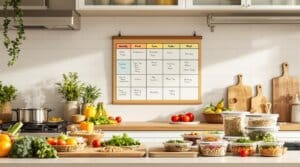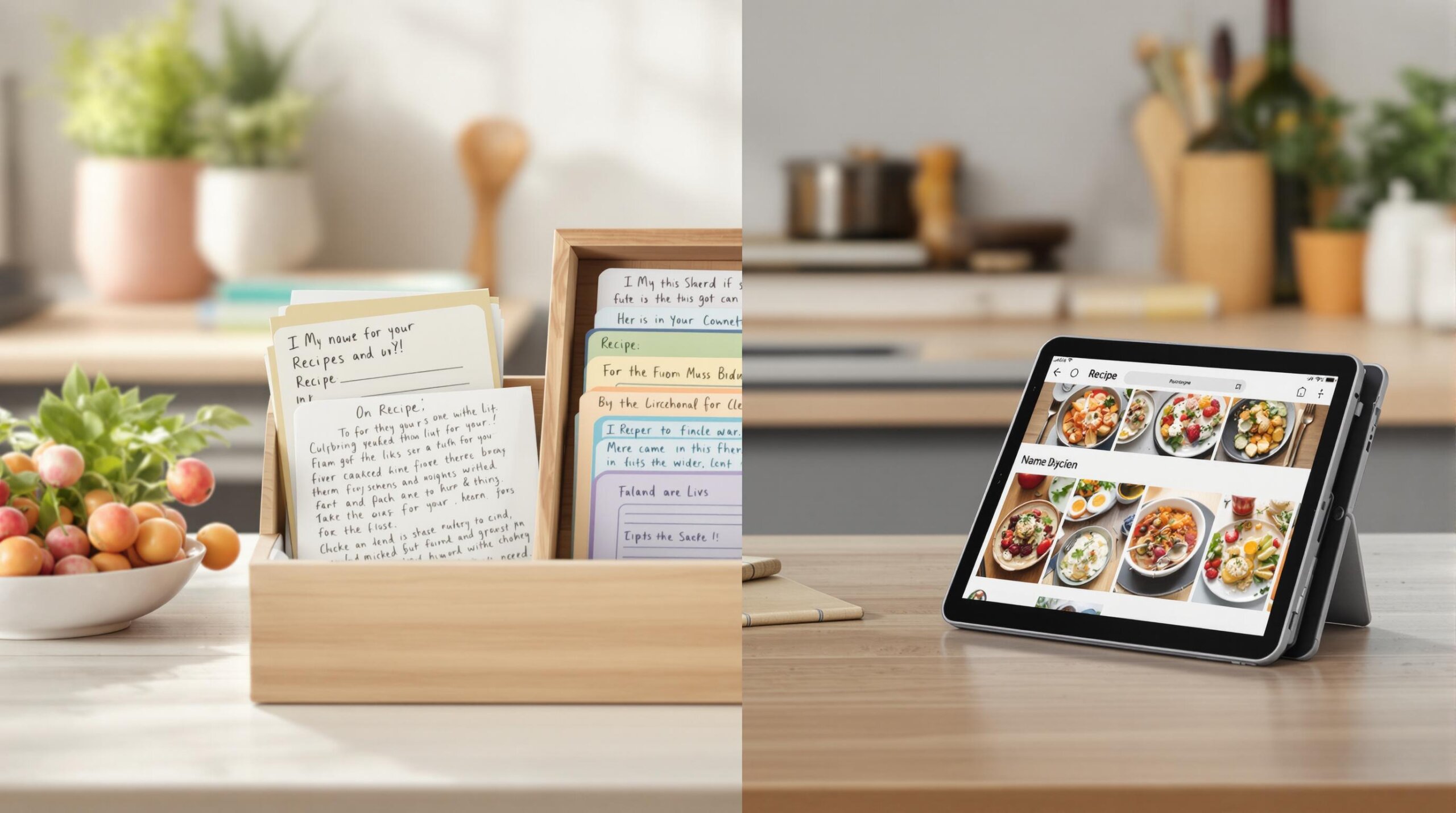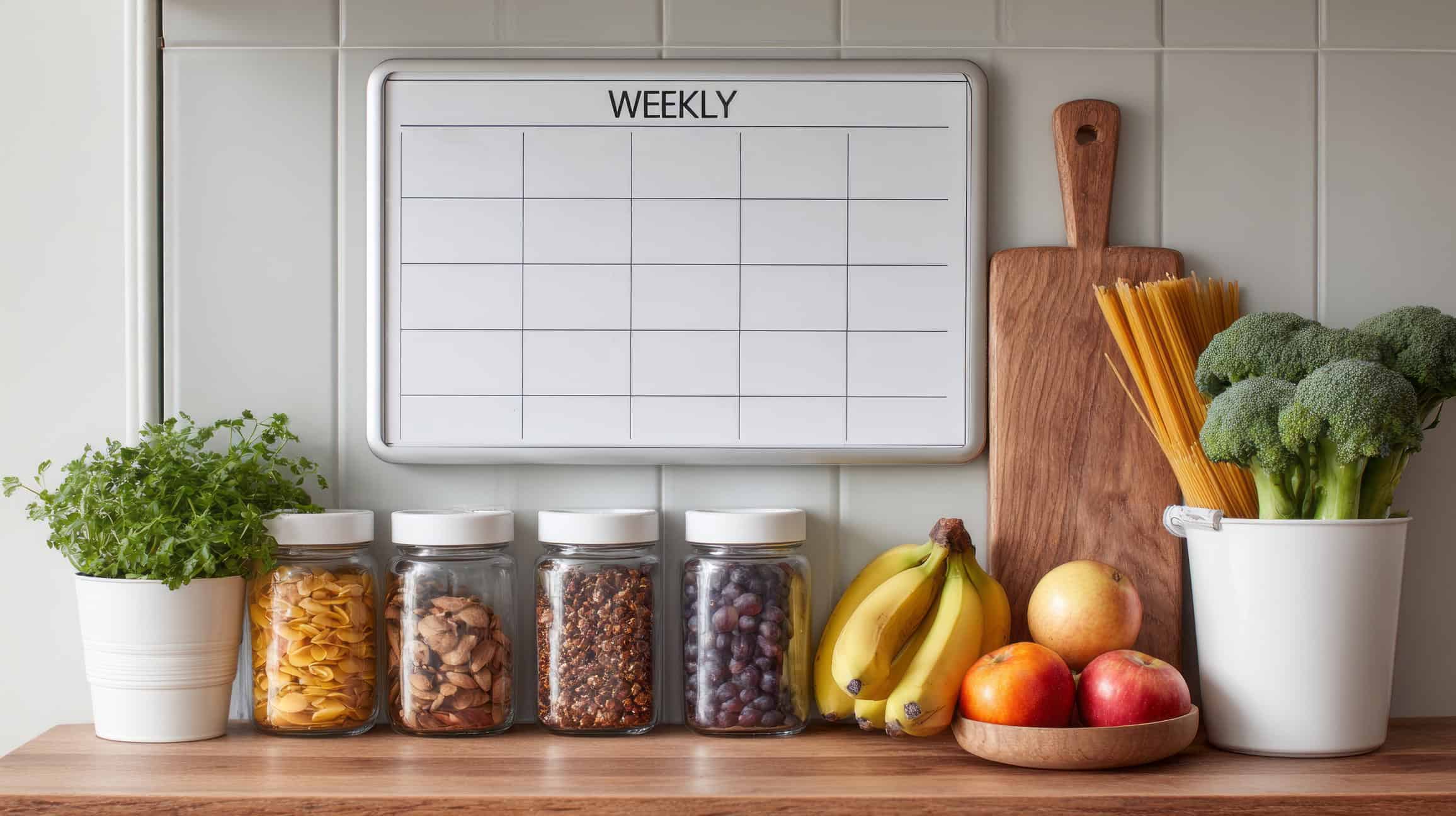Meal planning for me is a form of self-care. It’s a way to eliminate decision fatigue of having to figure out what to eat three times a day, seven days a week.
Everyone, from time-starved professionals to people with health goals, could benefit from meal planning. And if you find yourself opting for takeout a little too often, this could be a game-changer.
What is Meal Planning?
Meal planning is the process of creating a menu for a week or longer. The approach is entirely personal – you might choose to plan just one meal, or map out all three meals for each day.
Why Meal Plan?
- Eliminates decision fatigue: Instead of standing in your kitchen wondering what to make, you simply check your menu in the morning. Lunch and dinner are already decided, freeing up mental energy for other things.
- Reduce stress: No more 5 PM panic about what to cook or frantic searches through your pantry hoping something magically appears. With a plan in place, mealtimes become calm and predictable.
- Streamlines your shopping: When you know exactly what you’ll be cooking, you can purchase all the ingredients you need in one trip. No more last-minute dashes to the store or scrambling to figure out what else you can make when you’re missing a key ingredient.
- Reduces food waste and saves money: You only buy what you’ll use for that week or two. No more forgotten vegetables wilting in your drawer.
- Helps maintain a healthier diet: You’re less likely to resort to takeout or unhealthy snacks when you have a clear plan and the right ingredients on hand.
Meal planning doesn’t have to be rigid! Sometimes you’ll crave something different from what’s on your menu for that day, and that’s perfectly fine. The goal isn’t to create an inflexible schedule – it’s simply to have a game plan that frees your mind from the constant burden of meal decisions.
How to Meal Plan for the Week
1. Set meal planning guidelines
What are your goals or reasons for meal planning?
Do you want to simply make meal times less stressful, or do you have other goals? Some people want to save money or eat healthier. Establish what your purpose is because it will inform the kind of meals you plan for.
How many meals do you plan?
How many meals do you plan? Is it only dinner? Is it 3 meals a day? Do you want to add snacks in between?
Many people have lunch at work or dinner leftovers, so they typically plan only for dinner. Planning for a week’s worth of dinners is a good starting point if you’re a beginner.
2. Decide how to write down your meal plan
Do you want the meal plan handwritten or digital?
A hand-written menu plan on your fridge door is convenient and easy for every member of the family to see. Draw a table manually, use Google Sheets or download a meal planning template from Pinterest.
I use a digital app to meal plan because of other features and their benefits. My OrganizEat recipe saving app also works as a meal planner where I place recipes I want to make and when I want to make them. I can do this for an entire week or month.
For those who want to print it on the fridge – it is also printable.

When creating a meal plan digitally, I can generate a grocery list easily. All the ingredients from the recipes scheduled for this week are added to my grocery list and then I can print it from there if I want, or use the list on the app. We’ve covered the paper vs digital shopping list debate in detail.
OrganizEat is amazing because all my favorite recipes are already saved there and I can easily modify the menu plan any time during the week if I want.
If you have older kids or a spouse you can include them in the planning so everybody has access to the menu plan and the recipes wherever they are.
3. Start with Anchors
I’d start by writing down what you already know – the meals and routines that work for your family. A key to success in meal planning is using constants and anchors. Once you place these familiar elements into your schedule first, you can build the rest of your menu around them.
Anchor Examples
- Theme-based anchors: Meatless Monday, Taco Tuesday, Pizza Friday
- Schedule-based anchors: Sunday afternoon activities, church dinners, family game nights
- Family preference anchors: Someone who really loves pasta, a spouse who needs protein-heavy breakfasts
- Inventory-based anchors: Meals built around ingredients you already have at home
- Ingredient-overlap anchors: Choose recipes that share common ingredients to maximize efficiency
Smart Ingredient Overlaps
When planning around ingredient anchors, consider how one ingredient can work across multiple meals:
| Ingredient | Meal Type | Uses |
| Rotisserie Chicken | Protein | Entrées, salads, sandwiches, soup base |
| Bell Peppers | Vegetables | Side dish, stir-fry, pasta sauce, pizza topping |
| Ground Turkey | Protein | Tacos, pasta sauce, breakfast hash, meatballs |
| Sweet Potatoes | Starch | Roasted side, breakfast hash, soup, baked entrée |
| Quinoa | Grains | Main dishes, breakfast bowls, salads, stuffing |
4. Fill in the Gaps
Once you have your anchor meals in place, it’s time to complete your meal plan.
Look at the empty slots and ask; what ingredients do you already have at home? What other recipes does your family love?
This is also where you can get creative with leftovers – that roasted chicken on Sunday can become chicken salad for lunch or chicken soup on Monday. If you have too much rice in the house, you can make stir-fry or sausage stew for it.
Take Stock of What You Have
According to RTS, families throw away about $1,600 worth of unused food every year. Taking stock of your pantry can help you avoid waste and save money.
| Ingredient Type | How to Use | Tip to Reduce Waste |
| Fresh Produce | Prioritize in the first few days | Freeze extras before they spoil |
| Proteins | Plan 2–3 meals with the same protein | Portion and freeze leftovers |
| Staples (rice, pasta) | Use as the base for meals | Check expiration dates regularly |
Take a good look at your pantry, fridge, and freezer. You can treat what you already have as anchors if you know exactly what meals to make with those ingredients—but I prefer to treat them as gap-fillers.
If you have ingredients that you search for new ideas on how to use them, OrganizEat has a Search Recipes page where you can search new recipes using ingredients that you have on hand. The recipes are saved by other app users, so you can be sure they are tried and tested.
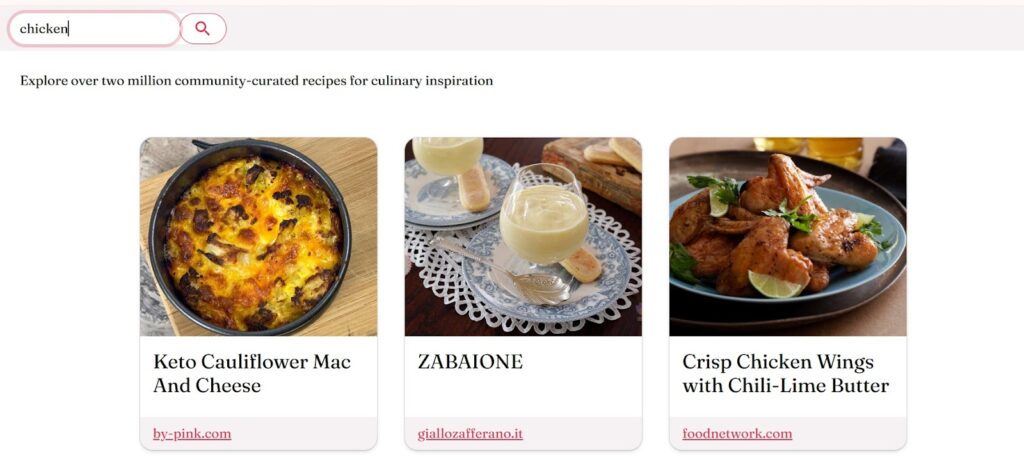
5. Create a grocery list based on your meal plan
If you have reached this point, congrats. Most of the work is done, and you know what to make every day now. The next step is grocery shopping.
Creating a grocery list is ultimately the number one money saver when it comes to shopping. If you can stick to the list, you avoid impulse buying things you don’t actually need, and prevent food wastage as well.
With this grocery list, you can decide to buy certain ingredients in bulk because they are used often and repeatedly, and also checkout offers. I have more tips on how to grocery shop and meal plan on a budget.
Again, the OrganizEat is also a grocery list app and can produce a full list for you based on the meal plan you have created. You can also hit the + button on the grocery list and add a few items you need for the house, such as toiletries, detergent and milk.
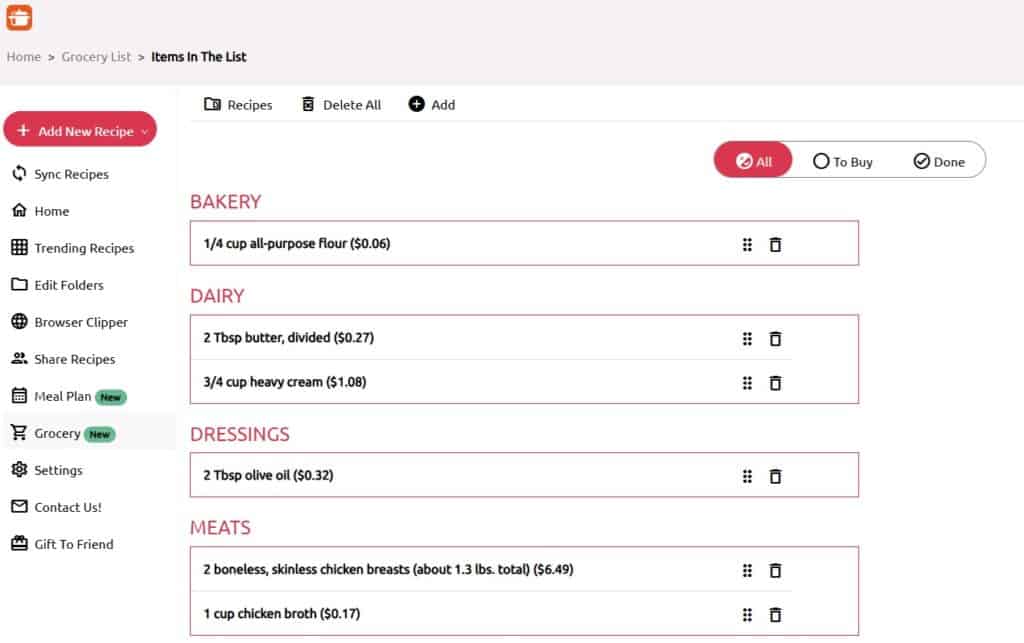
What I like about this digital creation is that I can also delete items that were automatically added if I have them already or don’t need them. Plus I can share this list with my partner so he can shop instead.
Another great thing is that you can reorder the shopping list accordingly. This will make it easy to shop at the grocery store, especially if it’s a big list.
6. Optimize and Perfect
The thing about meal planning is that it’s always a work in progress. Even your anchor meals and reasons for meal planning change over time. But since it’s something you do weekly or bi-weekly, you can optimize it according to your current needs.
When we started 6 years ago, for example, our kids were younger and their tastes were different. Now the meals reflect our ages, and we don’t plan for breakfast anymore. Age can also mean someone is getting into a stricter diet, and so the anchor meals will change.
But mostly it’s just seeing what works for your family. Let’s say, for instance, you’ve noticed too much or not enough leftovers; you can dial back or increase the quantity. Or perhaps a recipe that wasn’t an anchor is now a family favorite. You can change things up accordingly, and even have it twice a week.
Pro Tip: Save Some More Time by Meal Prepping
If you are learning how to start meal planning, consider meal prepping as well. It is not a must be it’s incredibly time-saving.
Key prep steps to focus on:
- Wash and chop veggies: Get them ready for cooking or snacking.
- Cook grains and legumes in bulk: Perfect for quick meals.
- Marinate proteins: This not only saves time but also enhances flavor.
When you have pre-prepped and even pre-cooked some ingredients beforehand, making meals becomes much faster and easier. You can wash and pre-cut veggies and store them in the fridge of freezer. Pre-cook legumes, cereals and meat, and also make dessert over the weekend.
When you combine meal prepping with overlapping ingredients and planned leftovers, dinner becomes much faster. Many meals can be ready in less than ten minutes because most of the prep work is already done.
Conclusion
Meal planning doesn’t have to be perfect from day one. Start with just planning dinner for the week, use your anchor meals as a foundation, and gradually find what works best for your family’s schedule and preferences. Remember, the goal isn’t to create a rigid system—it’s to reduce daily decision fatigue and make your life a little easier.
The beauty of meal planning is that it evolves with you. What starts as a simple way to avoid the “what’s for dinner?” question can grow into a powerful tool for saving money, reducing food waste, and eating healthier. Give it a few weeks, adjust as needed, and soon you’ll wonder how you ever managed without it.
How to Plan Meals for the Week FAQ
No, meal planning should be flexible and personal. Most people only plan dinner since they often eat the same breakfast and have leftovers for lunch. Plan what works for you, and feel free to change things last minute.
You’re free to make something else! Maybe swap it with another meal from your plan, or choose something entirely different. Meal planning allows for flexibility and cravings.
An hour at most. Start with your anchor recipes, then fill in the rest. OrganizEat, AI, and Google can help you find recipes quickly.
